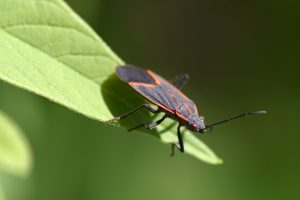This was originally posted in December 2017
P.J. Liesch, UW-Extension entomologist
Department of Entomology
UW-Madison College of Agricultural and Life Science
pliesch@wisc.edu
Twitter: @WIBugGuy
Total time 3:10
0:17 – Types of fall invaders
0:58 – Fall invader habits
1:31 – Managing fall invaders
2:57 – Lead out
Transcript
Zoey Rugel: Fall invader insects in your home. Today, we’re visiting with P.J. Liesch, Department of Entomology, Insect Diagnostic Lab, University of Wisconsin-Madison/Extension, in the College of Agricultural and Life Sciences and I’m Zoey Rugel. What are all these insects I see crawling around my house this fall?
P.J. Liesch: So, in late summer and into fall, we often get a number of different insects that like to hangout on the side of our homes, and I commonly refer to these as fall invaders. These are insects such as, box elder bugs, Asian lady beetles, cluster flies, brown marmorated stink bugs, western conifer seed bugs, and the main story with these is that they ultimately are looking for some type of overwintering spot. Out in the woods, they may get beneath the bark of a rotting, dead tree or into a rock pile, but with modern homes there’s often gaps in siding or around windows and doors. So, they often hang out on the sides of our homes. They’re looking for a way in to spend the winter.
Zoey Rugel: What are their habits?
P.J. Liesch: Each species has a little bit different habit during the growing season, but they all have some similar things that they do in the fall and that’s seeking out these overwintering spots. There’s often some triggers for some of these species and it often has to do with temperature changes in the fall, and when we get those first few days where we get close to frost temperatures at night, we get down into the 30s, that’s often a signal or trigger to these insects that winter is approaching and they need to start looking for these sheltered overwintering spots.
Zoey Rugel: How do we manage them?
P.J. Liesch: Well, a couple of things we can do to deal with these. The ultimate solution, although it’s not always necessarily feasible, if you can examine the outside of your home or other building and try and figure out where they’re sneaking in through. These could be gaps around windows or door frames, perhaps the weather stripping is worn out and doesn’t seal up as snuggly as it should, but if we can find where those entrance points are and do our best to seal it up, maybe seal things with caulk or expanding insulation foam or some other means and we can physically tighten things up, then those insects don’t have a way to get in in the first place and so that’s one way that we can deal with them is this physical exclusion method. So, a few other things we can do in those cases, if you have something like box elder bugs hanging out on the side of your house, we can often spray them with a soapy water solution and that can take care of the ones that you spray directly, but as soon as the soap dries out it stops working, so that’s really a temporary fix. If you were to call up a pest control company, their standard approach is often to spray a residual insecticide on the outside of your home and these products typically work for several weeks and they can do really two things. So, we spray around the windows and doors and other areas and if the insects contact those insecticides long enough it’s going to kill them out right, but in other cases the insects might come close enough and be irritated by those products and decide to go elsewhere. So, it can actually have some repellent properties, as well.
Zoey Rugel: We’ve been visiting today with P.J. Liesch, Department of Entomology, Insect Diagnostic Lab, University of Wisconsin-Madison/Extension in the College of Agricultural and Life Sciences and I’m Zoey Rugel.



